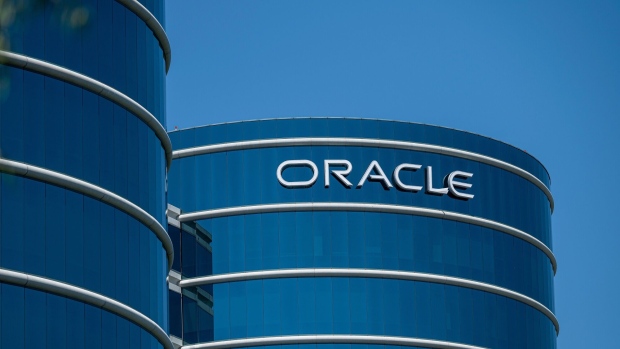Dec 11, 2023
Oracle Reports Disappointing Sales on Slowing Cloud Momentum
, Bloomberg News

(Bloomberg) -- Oracle Corp. plunged the most in three months after reporting that cloud sales growth had slowed for a second straight quarter, stoking investors’ concerns that the software maker’s expansion into a competitive market isn’t panning out as expected.
Cloud revenue rose 25% to $4.8 billion in the three months ended Nov. 30, the company said Monday. That follows a 30% gain in the previous quarter. Infrastructure growth also fell below analysts’ expectations, Bloomberg Intelligence’s Anurag Rana said, slowing from the prior three months.
Known for its database software, Oracle has been focused on expanding its cloud infrastructure business to more forcefully compete with the likes of Amazon.com Inc., Microsoft Corp. and Alphabet Inc.’s Google. That initiative to rent out computing power and storage over the internet hit a snag in September when Oracle reported its first infrastructure growth slowdown after more than a year of acceleration.
The shares dropped 12% to $100.81 at the close Tuesday in New York, the biggest single-day decline since Sept. 12. The stock has gained 23% this year.
Company executives attributed the slowdown to a lack of cloud server and graphics processing capacity, not customer demand. On the earnings call, Chief Executive Officer Safra Catz said the company will raise capital spending to bring more data centers online. She added that the company would have been able to recognize “hundreds of millions of dollars” more in quarterly cloud sales if capacity were available.
Chairman Larry Ellison said he sees cloud infrastructure growing “over 50% for a few years.” Wall Street signaled that it had expected a pickup sooner. “It may take a few quarters for this to resolve, as backlog continues to grow, Rana said.
Still, Oracle executives remained bullish on the business. Catz said in a statement that demand “is increasing at an astronomical rate.” Ellison said Oracle continues to spend to expand its capacity to provide computing power and other cloud services, including building 100 new data centers. “Demand is over the moon,” he said in the statement.
Future gains will hinge not just on customer demand, but the availability of graphics processors used in data centers to power artificial intelligence workloads, wrote Siti Panigrahi, an analyst at Mizuho, ahead of the results.
In the current quarter, total revenue should increase about 6.5%, Catz said on the call. Analysts, on average, estimated a 7.5% jump. Cloud sales, excluding revenue from the Cerner health unit, will gain about 27%, she said, which would be an acceleration from the fiscal second quarter. The company said it remained committed to its previous long-range financial targets for the 2026 fiscal year.
Oracle’s fiscal second-quarter sales increased 5% to $12.9 billion, the company said Monday, falling below analysts’ expectations of $13.1 billion. Profit, excluding some items, was $1.34 a share, compared with the average estimate of $1.33.
Of the cloud revenue, $1.6 billion came from renting out computing power and storage over the internet and $3.2 billion from applications.
Sales of Fusion software for managing corporate finance increased 21% in the quarter. Revenue from NetSuite, enterprise planning tools aimed at small- and mid-sized companies, also jumped 21%.
Another point of concern is that acquired health records business Cerner is growing slower than Wall Street expected. Management said in September that the company is working to shift Cerner’s legacy software business to the cloud, which means it must change the structure of contracts with many customers. Earlier this year, Oracle cut jobs in the division, which was purchased for about $29 billion in June 2022.
Half of all existing Cerner electronic health software customers will be on the cloud by February, Ellison said during the call. Cerner’s products are “very quickly moving from a license basis to a subscription basis,” he said.
Catz said Cerner revenue will decline 1 to 2 percentage points in the fiscal year. After that, the unit “will no longer be a drag on Oracle growth,” she said.
(Updates with closing shares in the fourth paragraph.)
©2023 Bloomberg L.P.





